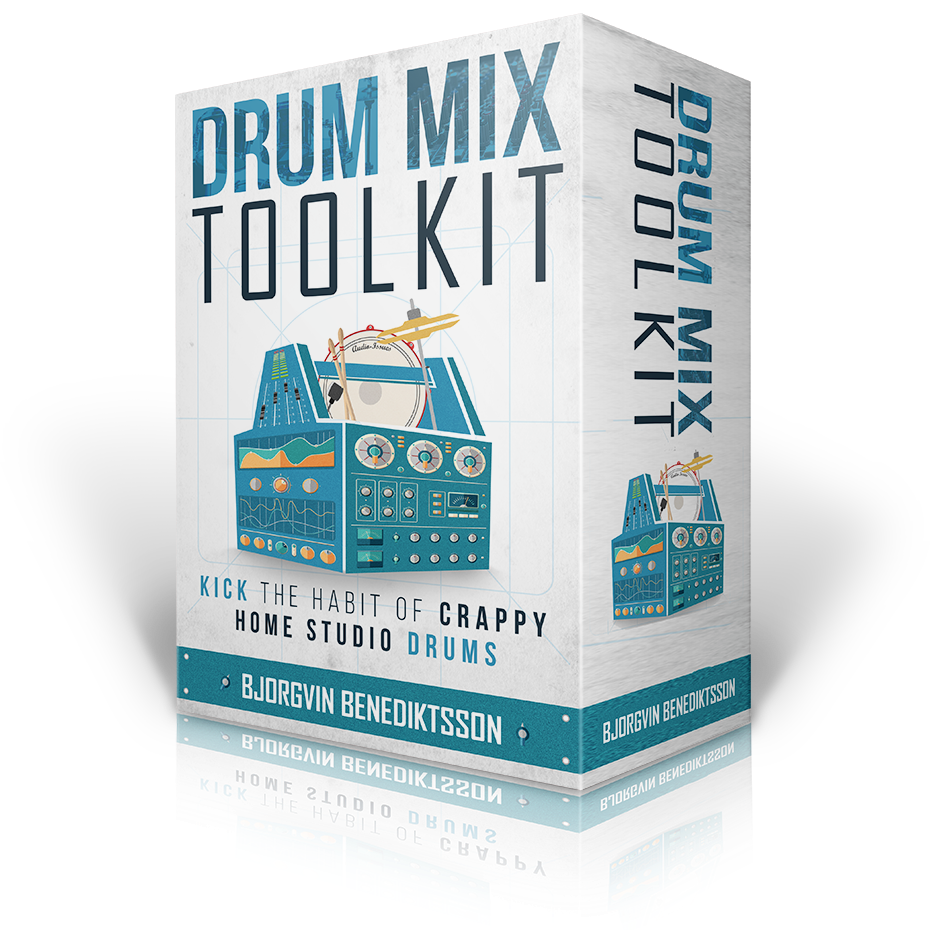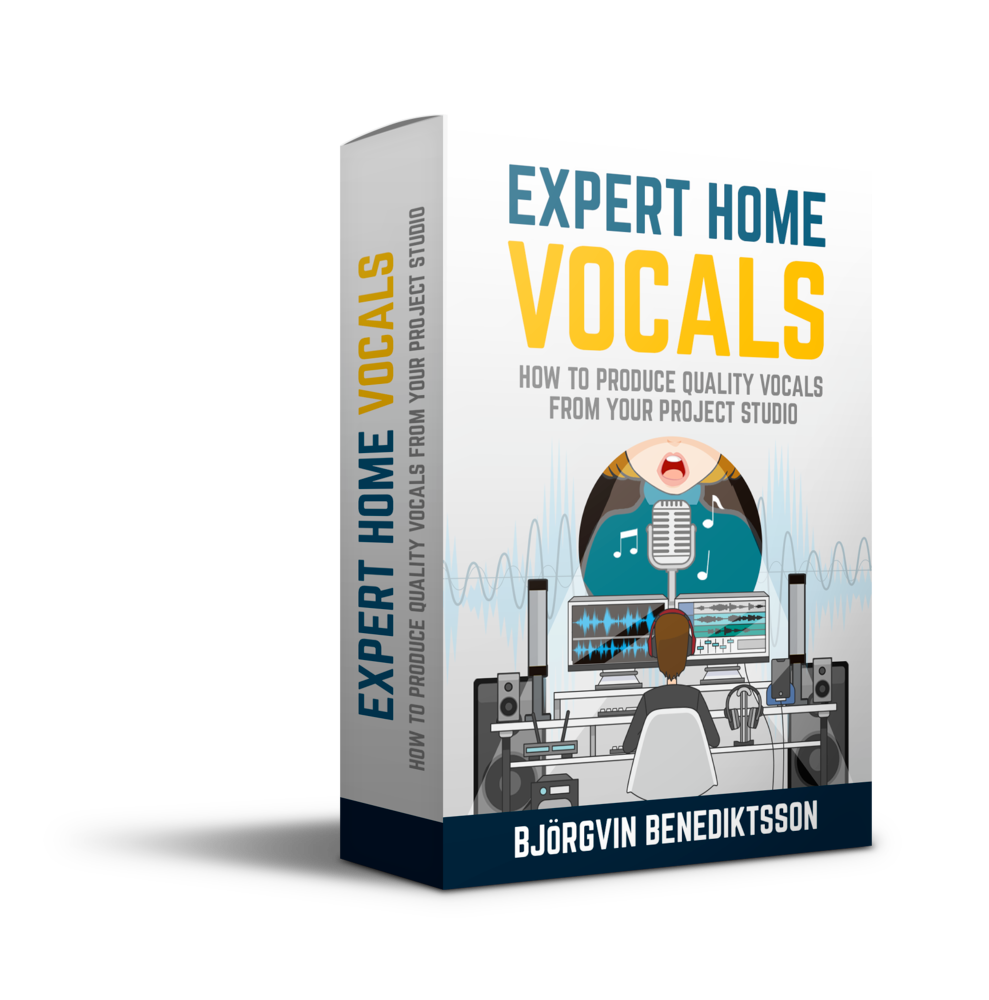For Home Studio Musicians and Bedroom Producers Looking to Get Rid of Their Weak Drums and Thin Vocals...
How to Create Powerful Drum Mixes and Produce Professional Vocals That Jump Out Of Your Speakers
These Are Your Two Bigggest Home Studio Problems
(Solve These Two Problems and You'll Instantly Improve Your Productions, Even If You Don't Have a Pro Studio and Without Buying Even More Plug-ins)
Most home studio musicians and bedroom producers struggle with two things:
- Getting a punchy and powerful drum mix.
- Producing a professional, clear, and full vocal sound.
Problem #1 - Shitty Drum Sounds
You start with the kick drum and no matter what you do it just sounds flabby.
The boominess overpowers the low-end and gives no room or definition to the bass guitar.
You can't find the right compression setting to keep the kick under control without making it sound over-compressed and lifeless.
Once you finally have your low-end tight you still can't get the snap of the beater to cut through the high-end, leaving you with a kick drum that's all oomph and no punch.
When you turn to the snare drum you immediately hear tough problems jumping out at you.
- There's an annoying ringing resonance that you just can't find.
- Whatever you do with your EQ, the snare either sounds too boxy or too thin.
- The hi-hat bleeds into the snare drum mic so much that it's almost impossible to get the snare to sit well without the hi-hat dominating your drum sound.
All you want is a powerful snare that drives the song forward, but all you're left with is a ringing snare that sits on top of the drums.
When the drummer plays a fill you hardly hear it because the toms are drowned out. When you push the volume up they just get in the way and sound detached, like somebody added a weird tom sample from another drum recording on top of the mix!
When you work on the overheads you can't get a good balance between the kick, snare, and the rest of the kit.
The drums were recorded in a boxy-sounding room so you try your best to EQ out as much of that hollow room sound but it always feels messy in the low-mids.
Every track you work on has that obvious amateur room reverb tail that you can't get rid of!
When you try to get your drums to sit forward in the mix they just end up getting in the way of the rest of the arrangement.
Adding reverb just makes it worse, muddying up the drum sound and leaves it sounding distant and under the rest of the mix.
After all that trial and error you might have a good beat going, often the rest of the instruments seem to fall into place.
And once you've mixed all the instruments to the drums, the only thing left is producing the vocals.
And that brings up a whole host of new problems.
Problem #2 - Weak Vocals
Chances are, you don't know if you're using the right microphone for your vocal.
You might not even be sure whether you're getting the correct levels on your interface when you're getting ready to record.
And when you place the mic in front of the singer, you get a small and noisy voice instead of the round, warm, and present vocal sound you hear on your favorite records
Even though you've experimented with different mic techniques, you either end up with a muddy, honky sound (like you're speaking with your hands over your mouth)...or you'll get a thin, sibilant voice that sounds too far away.
Once you think you got a decent vocal to work with, you still don't know how to use tuning, aligning, and editing to make your vocals sound tighter and more professional.
In the mix, you wish you could get the music and vocals to sound balanced. You wish you could find that perfect middle ground of big vocals that don't muddy up the mix.
Instead of full, rich, and thick vocals that pop out of the mix, you end up with a thin and harsh mess that's buried underneath the instruments!
Although you've tried all the Youtube tricks, like parallel compression, duplicating tracks and applying different processing on each vocal track, your vocals still don't sound like the professional recordings you like so much.
Maybe you've all but given up trying to get great drum mixes and produce professional vocals in your home studio.
If that's the case, please don't give up yet!
Hi, I'm Björgvin Benediktsson
I’m the author of the #1 Amazon best-seller, Step By Step Mixing: How to Create Great Mixes Using Only 5 Plug-ins and the founder of Audio Issues.
I've worked as a live sound engineer, a broadcast recording engineer, a professional touring musician, and a freelance mixing and mastering engineer. Since 2009, I've been helping people like you transform their rough recordings into professional records they can be proud to release.


Imagine if you could start creating professional, studio-quality drum mixes and clean and powerful vocal productions from your home studio, even if you don't have expensive equipment.
If you’re tired of dealing with shitty drum sounds and weak vocals and want to know exactly how to mix your drums and produce your vocals, then you might relate to this story:
When I was in a band in high school, we produced our first album by ourselves.
We set up a recording studio in our rehearsal space, got a few mics, a mixer, and got to work.
During the year-long process of recording, two things stood out as the biggest problems:
- Our drum sound
- Our vocal production
As a rock band, we wanted a powerful, punchy, and thick drum sound like the rock bands had at the time. However, with our limited mixing knowledge, it was hard to replicate.
And when we had finished the production, even with subpar drum sounds, we struggled to get a good vocal sound.
We would set up a vocal session without having a clue what we needed.
We had the worst budget microphones and we had no idea where to position the mic so it often sounded thin and harsh - a far cry from the powerful rock vocals we were looking to emulate.
If you’ve ever gotten a drum recording from a band and you’re immediately exhausted just thinking about how to transform those crappy drums into powerful drum mixes...
...or you've found yourself pulling your hair out because the vocals were out of tune and uninspiring...
...then you know how we sounded.
We were that band!
Luckily, things have changed since then and I've quite a bit about drums and vocals, but it's still a huge problem my audience faces.
Maybe you can relate?
It’s been a while since I was in that first band, and in the last decade or so I’ve learned a lot about tackling those problems.
My drum mixes now sound powerful and punchy
- I learned how to fix muddy drum sounds with specific EQ cuts.
- I discovered how to add punch and dynamics to the drum bus with multi-band compression.
- I figured out how to gate the drums to get rid of unnecessary bleed (GOODBYE HI-HAT HISS!).
And I learned how to blend the right drum reverbs into the mix to keep the drums present while staying out of the way of the arrangement.
Transient designers allowed me to add attack to dull-sounding drums.
They helped me get rid of the room reverb in my home recordings and gave me tighter tracks to work with.
And when that didn’t work, I turned to advanced drum sampling techniques to get whatever sound I wanted.
As for vocals...
- I learned to use EQ and compression to make the vocal come alive.
- If I needed to subtly tame the vocals to fit in a dynamic ballad, it was easy.
- If I wanted the vocals aggressive and in-your-face for a rock recording, that was no problem either.
And with the right processing, I could find the exact point where the vocals would fit with the instruments without sounding glued on top or buried underneath.
After solving these problems for so long I realized that I had created my own type of toolkit to tackle each of these tricky situations.
Whenever I ran into a specific problem I had a tool that would solve it.
And now I want to share those tools with you...
Introducing: The Drum Mix Toolkit and Expert Home Vocals Production Bundle
Your Solution to Mastering Punchy Drum Mixes and Powerful Vocals

Drum Mix Toolkit - Kick the Habit of Crappy Home Studio Drums
Drum Mix Toolkit is your one-stop-shop to getting professional drum mixes from your home recordings. If you've been needing to learn how to mix acoustic drums or breathe new life into your programmed samples, you'll discover new techniques and a solid foundation of knowledge to do just that.
- An In-Depth eBook to Create Punchy and Powerful Drum Mixes
- 11 Quick Tip Videos to Teach You How to Get Great Drum Mixes Right Away
- 2 In-Depth Drum Mixing Walkthroughs Using Both Acoustic Drums and Samples

Expert Home Vocals - How to Produce Quality Vocals from Your Project Studio
Expert Home Vocals combines everything I know about producing pro vocals in the home studio. Expert Home Vocals helps you bypass the mistakes I made so that you can get professional vocals from your home studio in weeks instead of years.
- An In-Depth eBook for Producing Professional Vocals from Your Home Studio
- Video Training Bundle To Help You With Pre-Production, Recording, and Mixing Pro Vocals
- Bonus Vocal Microphone Buyer Guide for Any Budget, and Top 10 Vocal Effects Masterclass

"What I've learned in this package will be used on my bands/brothers' drum tracks for years to come!"
"Drum Mix Toolkit is a fantastic resource. Not only is it a well-written book full of tips, tricks, and workflow methods that you can implement today, but to me, the best part is that it also contains video examples by Bjorgvin himself so you can actually hear the techniques in action! It's one thing to read about audio, but it's another to see exactly how to use these techniques in a real session, and more importantly, to hear the differences made through the process. To top it off, Bjorgvin has provided the practice tracks he used in the videos for free as well! Absolutely fantastic and highly recommended! What I've learned in this package will be used on my bands/brothers' drum tracks for years to come!"
-Jonathan Timpe, Musician/Engineer

"an excellent job of explaining concepts and uses “real world” situations to convey concepts. A well-thought-out and planned resource!"
"A great, well-rounded source of information of dealing with vocals from start to finish. I’m mainly schooled in the “analog years” and still working through the digital age. In everyone’s case, there is always something else to learn or grasp. [Expert Home Vocals] added clearer information on gain staging, especially when using plug-ins, added more information on signal processing and in general added more explanations of possibilities to use plug-ins in different situations, such as recording group vocals, harmonies, and micing...What surprised me most was the amount of precise information included, as well as very helpful examples of using what is explained. Björgvin does an excellent job of explaining concepts and uses “real world” situations to convey concepts. A well-thought-out and planned resource!"
-Pat Cycz, Musician/Studio Owner
Here's What You'll Learn from the Drum Mix Toolkit
- 9 Simple Steps to a Great Drum Mix
- How Your Polarity Switch Can Mean the Difference Between "Thin and Weak" or "Thick and Tight"
- How to Simplify Your Drum Sound to Make Your Mixing More Efficient
- How to Use Bus Processing and Parallel Compression to Glue Your Drum Sound Together
- How to Use Sample Replacement to Save a Shitty Drum Sound From Itself
- How to Use the Secret Weapon of the Transient Designer to Shape Your Drum Sounds Into What You Hear in Your Head
- How to Blend Multiple Reverbs Together in Your Drum MIx, Making the Drums Sound Larger than Life
- How to Fit the Kick Drum and Bass Guitar Together in the Low End
- How to Use the Volume Faders to Get the Correct Balance From Your Drums (WHAT A NOVEL IDEA?!?!)
- How to Take Full Advantage of the Phase Relationship Between Your Tracks to Make Every Track Sound Tighter
- 4 Different Ways of Grouping Your Drums for Easy Mixing
- What Processing to Use When You Don't Have Drum Replacement or Transient Designers at Your Disposal
- Where to EQ Drums to Get Rid of Boxiness, Muddiness, and Harshness
- Why Your EQ is Kind of Like the Jedi's Trusty Lightsaber
- Your 6 Step Process for Using Drum Compression for Tighter Drums
- A Behind the Scenes Look at How the Ratio of Your Compressor Affects Your Drum Sound
- When to Choose FET, OPTO or VCA Compression Styles
- How to Use Multi-Band Compression for a Tighter, Yet MORE Dynamic Drum Sound
- How to Use Gates to Get a Cleaner Drum Sound
- What to Avoid When Gating the Kick and Snare
- Why You Should Use Analog Summing and Saturation to Add More Warmth and Depth to Your Drums
- Why Fleetwood Mac's "Rumours" is the Reason I Use This One Plug-in on ALL My Mixes
- How to Use Parallel Compression to Add Power to Your Drums
- Specific EQ and Compression Guides for Kick, Snare, Toms and Overheads
- How to Side-Chain the Bass to Get the Kick to Cut Through
- How to Get a Thunderous Tom Sound in Three Steps
- The Difference Between a Drastic and Subtle Overhead EQ (And When to Choose Which)
- Adding Space to Your Drum Mix Without Making Your Drums Sound Distant
- How to Use Two Separate Reverbs on the Snare to Get it to Stand Out
- How to Select the Right Reverb Mode For Your Song
- How to Use Gated Reverbs Without Sounding Like You're an 80's Cover Band
- How to Get Rid of Ringing Drum Sounds
- How to Get the Kick and Bass Guitar to Move Together in the Mix
- How to Use Sample Replacement Without Sacrificing the Human Feel
Listen to How a Student Transformed His Drum Sound After the Drum Mix Toolkit
Peter Thompson of The Magic Es remixed one of his songs, "Headrush," after learning the techniques inside the Drum Mix Toolkit. He made the entire kit sound punchier, more present and powerful after the remix.
Click the video to hear the before/after transformation.

"helped me understand the way of thinking when mixing drums....I honestly can’t find something that I did not like."
"found a lot of tricks and tips for mixing drums. I also realised that I had totally misunderstood what compression ratio is. Now everything is clear. You did a serious and really good work...it helped me understand the way of thinking when mixing drums. And I think that was the most important. Every detail was helpful because I had previous knowledge for mixing drums but I was missing some important information on EQ and Compression which is now clearer. Transient Designers rock!!! I honestly can’t find something that I did not like. From the book and the way the content is presented in clear chapters to the incredible videos. Everything was great. Really good value for money.”
-Louis Georgiou, Musician
Here's What You'll Learn From Expert Home Vocals
Effective Vocal Pre-Production to Make the Best Song Possible
Getting Your Home Studio Ready and Making Your Singer Comfortable
Easy Recording Techniques to Get a Great Vocal Sound Right at the Source
How to Comp, Edit, and Tune Vocals for a Larger-Than-Life Vocal Track
How to Mix Pro Vocals That Fit With All the Instruments in Your Mix

"This is an excellent course in one of the most important aspects of recording, getting the vocals right."
"...this is an excellent course in one of the most important aspects of recording, getting the vocals right. I like how in this course Björgvin goes through the whole process of recording vocals without skipping a beat, so to speak. He does not just talk about mic technique and mixing, although he has plenty of excellent tips on these subjects. He also talks about the importance of pre-production and making sure that the vocalist is comfortable in the studio, and how things that some engineers might not think about, like the lights, or the quality of the headphone mix can affect the mood and therefore the vocal performance. Overall this is an excellent course in one of the most important aspects of recording, getting the vocals right."
Haukur "Hawk" Pálmason,Recording Engineer (Credits include symphony recordings for the TV show Vikings), Iceland

"using the Stereo Spread plugin as a side-chain had never occurred to me!"
"I just realized that, especially considering you have focused SO much time on recording/mixing/producing, that there's GOT to be some golden nuggets I'm gonna get from this class to really make my vocals more amazing. My only doubt was whether I would really learn something new. Well, in the email you sent out where you showed an example of your vocal bus, using the Stereo Spread plugin as a side-chain had never occurred to me! So that convinced me that, as usual, I don't know what I don't know, and for $100 I'm gonna get better. Actually, I already used that Stereo Spread on the side chain last night and I like the results better than having it on the main channel's bus (like I've always done before).”
-Rebecca De La Torre, Recording Engineer and Musician, Topkat Studios, Tempe, AZ
Take a Look Inside Drum Mix Toolkit and Expert Home Vocals
As soon as you join, you'll have instant access to the course materials on both your computer and mobile device. All modules have both video and written content.

The Iron-Clad Audio Issues 100% Risk-Free Money-Back Guarantee
As with all of the Audio Issues products, Expert Home Vocals comes with a 100% risk-free money-back guarantee.
I promise that following the workflow inside Drum Mix Toolkit and Expert Home Vocals will make every drum mix and vocal production session easy to work on because you'll know exactly what to do to transform your amateur demos into powerful and professional productions.
There is a reason my students have told me that my training has "instantly improved their mixes." Your fans will love the new professional sounds you're releasing, and you'll impress every new client that comes to your studio because you'll easily show them how good you can make them sound.
You can go through all of the materials, watch all the videos and browse all the bonuses before you even make up your mind. You can try all the tricks and even keep the training for a full year before deciding whether you like them or not. If at any point you decide that Drum Mix Toolkit and Expert Home Vocals didn't skyrocket the quality of your productions, simply email me for a full refund, no questions asked nor strings attached!
"I take my guarantee very seriously. I am not interested in keeping your money if you don’t learn anything from what I’m creating for you.
So if you’re not happy, I’m not happy. Simple as that."
You'll Also Get These Exclusive Bonuses When You Buy Today
Drum Mix Toolkit Bonuses
- 25 Drum Mixing Resources to Improve Your Mixes Even Further
- An Overview of Popular Sample Replacement Tools
- Where to Find Transient Designer Plug-ins
- Resources for Practice Materials
- Advice on Making Your Mixes Translate to Every Speaker
- Practice Drum Tracks to Improve Your Drum Mixes
- Percussion Toolkit PDF Guide: Make Your Percussion Shine Through


Expert Home Vocals Bonuses
- Vocal Effects Masterclass - Top 10 Vocal Processing Techniques for Pro Vocals. Whether you’re looking for parallel processing tricks for larger vocals, cool slapback echoes, advanced double-tracking or aggressive megaphone effects, you’ll learn them in here.
- Vocal Microphone Buyer’s Guide: How to Find the Right Vocal Recording Microphone If You’re on a Budget.
"I was looking for something more advanced, I found myself saying "wow, that's a great way to look at that" a lot...I think you are a great teacher and a great musician."
"You write and teach in a way that completely makes the concept or the task easy to understand. I just wanted to tell you that. Even though I have known these techniques for a while and are very familiar with them and I was looking for something more advanced, I found myself saying "wow, that's a great way to look at that" a lot...I think you are a great teacher and a great musician. Thank you for reminding me that I have at least grown a bit, but even more so, thank you for inspiring me and helping me to push forward, grow, organize, plan, and to stay positive so many times through the writings in your emails. I really appreciate it!"
-Daniel Po, Home Studio Musician
"Before reading this material my mixes were dull and muddy. Thanks to this knowledge I have pulled them out of the muck and they sound more professional than ever."
"Your training bundle helped my mixes a lot! Two techniques that come to mind are subtractive EQ and the proper use of reverb. I am currently working on a project with 20 plus tracks, many in the mid-zone of the EQ (several string tracks, piano and a few guitars clean and dirty). With the help of your books I have cleaned up most of the mud. Anyway thanks for sharing your recording knowledge with us...have helped my recordings immensely! Before reading this material my mixes were dull and muddy. Thanks to this knowledge I have pulled them out of the muck and they sound more professional than ever."
-Paul Ranson, Project Studio Engineer
Do You Give a FAQ About Great Drum Mixes and Pro Vocals? Because I Do...
How are Drum Mix Toolkit and Expert Home Vocals delivered?
Do I need a specific DAW?
Can't I just Youtube this stuff?
I've bought other tutorials, how is this one different?
What if I don't have time?
Do I need any specific plug-ins?
I use only midi drums, or only mix drum samples. Realistically, will this book help in that situation?
Is this for beginners or advanced engineers?
I only do [insert complicated and random genre here]. How will this help me?
"But music just a hobby to me..."
"But I'm just a live sound guy...will this help?"
Can I buy the courses separately?
You Have Two Choices for Your Drum Mixes and Vocal Productions
Choice #1 - Improve Your Productions
If you buy today, you'll learn a proven method I've used throughout my career to make professional-sounding drum mixes and vocal productions in my home studio, often using budget microphones and cheap gear.
If you join today, you can say goodbye to any insecurity you may have about drum mixing. or vocal production from your home studio.
If you join today, you'll be a whiz at drums and vocals...GUARANTEED or your money back.
The worst-case scenario of learning from Drum Mix Toolkit and Expert Home Vocals?
Pro vocals and punchy drum mixes from your home studio in less than a week.
Choice #2 - Do Nothing
If you do nothing, you won't know what to do when you need to knock that drum mix out of the park or get a great vocal sound that makes your mix come alive.
If you do nothing, you'll keep making the same mistakes over and over instead of following a proven method for professional drum mixes and quality vocals.
The worst-case scenario from doing nothing?
You'll keep getting the same shitty drum sounds and amateur sounding vocals that sound thin, harsh, and uninspiring, instead of publishing your productions and proudly sharing them with your friends and fans
Ready for Awesome Drum Mixes and Professional Vocals?
Click the button below to get instant access to the Drum Mix Toolkit and Expert Home Vocals Production Bundle.
Once you finish the checkout process you'll be emailed your log-in information to access the members' area.
Drum Mix Toolkit and Expert Home Vocals
Only $97
Instant Access - 100% Satisfaction Guaranteed
Yes! Give Me the Drum Mix Toolkit and Expert Home Vocals Production Bundle!P.S.
Here's my promise to you:
In only a few hours, you'll learn drum mixing and vocal production techniques that took me over a decade to learn.
No boring theory, just practical advice on how to create kick-ass drum mixes and professional vocals from your home studio. Whether you're a novice beginner or a professional veteran, the techniques inside Drum Mix Toolkit and Expert Home Vocals are sure to give you brand new ideas to try out in your mixes.
Enjoy!
Björgvin
